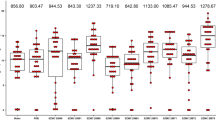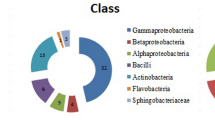Abstract
Soil bacteria may have properties of plant growth promotion but not be sufficiently beneficial for plants under stress conditions. This challenge has led researchers to extend their searches into extreme environments for potential soil bacteria with multiple plant beneficial traits as well as abiotic stress tolerance abilities. In the current study, an attempt was made to evaluate soil bacteria from an extreme environment, volcano soils, based on plant growth promoting and abiotic stress mitigating characteristics. The screening led to the isolation of eight (NBRISH4, NBRISH6, NBRISH10, NBRISH11, NBRISH13, NBRISH14, NBRISH16 and NBRISH26) bacterial isolates capable of withstanding stresses, namely temperature (up to 45 °C), salt (up to 2 M NaCl) and drought (up to 60% Poly Ethylene Glycol 6000) in vitro. Further, the selected isolates were notable for their in vitro temporal performance with regards to survival (in terms of colony count), phosphate solubilisation, biofilm formation, auxin, alginate and exo-polysaccharide production abilities under abiotic stresses i.e. 40 °C temperature; 500 mM NaCl salt and drought (PEG) conditions. In vivo seed treatments of individual selected bacteria to maize plants resulted into significant enhancement in root and shoot length, root and shoot fresh and dry weight and number of leaves per plant. Overall, the plant growth promoting and abiotic stress tolerance ability was most evident for bacterial isolate NBRISH6 which was identified as an Ochrobactrum sp. using 16S rRNA based phylogenetic analysis.




Similar content being viewed by others
References
Abiala MA, Odebode AC, Hsu SF, Blackwood CB (2015) Phytobeneficial properties of bacteria isolated from the rhizosphere of maize in southwestern Nigerian soils. Appl Environ Microbiol 81:4736–4743. doi:10.1128/AEM.00570-15
Amaresan N, Kumar K, Sureshbabu K, Madhuri K (2014) Plant growth-promoting potential of bacteria isolated from active volcano sites of Barren Island, India. Lett Appl Microbiol 58:130–137. doi:10.1111/lam.12165
Barea JM (2015) Future challenges and perspectives for applying microbial biotechnology in sustainable agriculture based on a better understanding of plant-microbiome interactions. J Soil Sci Plant Nutr 15:261–282
Bharucha U, Patel K, Trivedi UB (2013) Optimization of indole acetic acid production by Pseudomonas putida UB1 and its effect as plant growth-promoting rhizobacteria on mustard (Brassica nigra). Agric Res 2:215–221. doi:10.1007/s40003-013-0065-7
Bogino PC, Oliva MDLM, Sorroche FG, Giordano W (2013) The role of bacterial biofilms and surface components in plant-bacterial associations. Int J Mol Sci 14:15838–15859. doi:10.3390/ijms140815838
Brick JM, Bostock RM, Silversone SE (1991) Rapid in situ assay for indole acetic acid production by bacteria immobilized on nitrocellulose membrane. Appl Environ Microbiol 57:535–538
Cardinale M, Ratering S, Suarez C, Montoya AMZ, Geissler-Plaum R, Schnell S (2015) Paradox of plant growth promotion potential of rhizobacteria and their actual promotion effect on growth of barley (Hordeum vulgare L.) under salt stress. Microbiol Res 181:22–32. doi:10.1016/j.micres.2015.08.002
Cattelan AJ, Hartel PG, Furhmann JJ (1999) Screening for plant growth-promoting rhizobacteria to promote early soybean growth. Soil Sci Soc Am J 63:1670–1680. doi:10.2136/sssaj1999.6361670
Chakrabarty AM (1981) Microorganisms having multiple compatible degradative energy-generating plasmids and preparation thereof. US patent 4,259,444
Chaudhry V, Bhatia A, Bharti SK, Mishra SK, Chauhan PS, Mishra A, Sidhu OP, Nautiyal CS (2015) Metabolite profiling reveals abiotic stress tolerance in Tn5 mutant of Pseudomonas putida. PLoS ONE 10:e0113487. doi:10.1371/journal.pone.0113487
Chauhan PS, Nautiyal CS (2010) The purB gene controls rhizosphere colonization by Pantoea agglomerans. Lett Appl Microbiol 50:205–210. doi:10.1111/j.1472-765X.2009.02779
Chien A, Edgar DB, Trela JM (1976) Deoxyribonucleic acid polymerase from the extreme thermophile Thermus acquaticus. J Bacteriol 127:1550–1557
Dastager SG, Lee JC, Ju YJ, Park DJ, Kim CJ (2009) Leifsonia kribbensis sp. nov., isolated from soil. Int J Syst Evol Microbiol 59:18–21. doi:10.1099/ijs.0.001925-0
Fiske CH, Subbarow Y (1925) The colorimetric determination of phosphorus. J Biol Chem 66:375–400
Gadhave KR, Hourston JE, Gange AC (2016) Developing soil microbial inoculants for pest management: can one have too much of a good thing? J Chem Ecol 42:348–356. doi:10.1007/s10886-016-0689-8
Gao Y-Z, Liu H, Chao H-J, Zhou N-Y (2016) Constitutive expression of a Nag-like dioxygenase gene through an internal promoter in the 2-chloronitrobenzene catabolism gene cluster of Pseudomonas stutzeri ZWLR2-1. Appl Environ Microbiol 82:3461–3470. doi:10.1128/AEM.00197-16
Gopalakrishnan S, Sathya A, Vijayabharathi R, Varshney RK, Gowda CLL, Krishnamurthy L (2015) Plant growth promoting rhizobia: challenges and opportunities. 3 Biotech 5:355–377. doi:10.1007/s13205-014-0241
Gupta G, Parihar SS, Ahirwar NK, Snehi SK, Singh V (2015) Plant growth promoting rhizobacteria (PGPR): current and future prospects for development of sustainable agriculture. J Microb Biochem Technol 7:96–102. doi:10.4172/1948-5948.1000188
Hall TA (1999) BioEdit: a user-friendly biological sequence alignment editor and analysis program for Windows 95/98/NT. Nucl Acids Symp Ser 41:95–98
Hayat R, Ali S, Amara U, Khalid R, Ahmed I (2010) Soil beneficial bacteria and their role in plant growth promotion: a review. Ann Microbiol 60:579–598. doi:10.1007/s13213-010-0117-1
Khan N, Mishra A, Chauhan PS, Sharma YK, Nautiyal CS (2012) Paenibacillus lentimorbus enhances growth of chickpea (Cicer arietinum L.) in chromium-amended soil. Antonie Van Leeuwenhoek 101:453–459. doi:10.1007/s10482-011-9637-3
Khare E, Arora NK (2010) Effect of indole-3-acetic acid (IAA) produced by Pseudomonas aeruginosa in suppression of charcoal rot disease of chickpea. Curr Microbiol 61:64–68. doi:10.1007/s00284-009-9577-6
Kloepper JW, Beauchamp CJ (1992) A review of issues related to measuring of plant roots by bacteria. Can J Microbiol 38:1219–1232. doi:10.1139/m92-202
Laditi MA, Nwoke OC, Jemo M, Abaidoo RC, Ogunjobi AA (2012) Evaluation of microbial inoculants as biofertilizers for the improvement of growth and yield of soybean and maize crops in savanna soils. Afr J Agric Res 7:405–413. doi:10.5897/AJAR11.904
Mei GY, Yan XX, Turak A, Luo ZQ, Zhang LQ (2010) AidH, an alpha/beta-hydrolase fold family member from an Ochrobactrum sp. strain, is a novel N-acylhomoserine lactonase. Appl Environ Microbiol 76:4933–4942. doi:10.1128/AEM.00477-10
Meintanis C, Chalkou KI, Kormas KA, Karagouni AD (2006) Biodegradation of crude oil by thermophilic bacteria isolated from a volcano island. Biodegradation 17:3–9. doi:10.1007/s10532-005-6495-6
Meng X, Yan D, Long X, Wang C, Liu Z, Rengel Z (2014) Colonization by endophytic Ochrobactrum anthropi Mn1 promotes growth of Jerusalem artichoke. Microb Biotechnol 7:601–610. doi:10.1111/1751-7915.12145
Meyer JM, Abdallah MA (1978) The florescent pigment of Pseudomonas fluorescens biosynthesis, purification and physical-chemical properties. J Gen Microbiol 107:319–328. doi:10.1099/00221287-107-2-319
Mishra S, Mishra A, Chauhan PS, Mishra SK, Kumari M, Niranjan A, Nautiyal CS (2012) Pseudomonas putida NBRIC19 dihydrolipoamide succinyltransferase (SucB) gene controls degradation of toxic allelochemicals produced by Parthenium hysterophorus. J Appl Microbiol 112:793–808. doi:10.1111/j.1365-2672.2012.05256
Nautiyal CS (1997) A method for selection and characterization of rhizosphere-competent bacteria of chickpea. Curr Microbiol 34:12–17. doi:10.1007/s002849900136
Nautiyal CS (1999) An efficient microbiological growth medium for screening phosphate solubilizing microorganisms. FEMS Microbiol Lett 170:265–270. doi:10.1111/j.1574-6968.1999.tb13383
Nishiyama M, Watanabe Y, Marumoto T (1998) Bacterial 16S rDNA sequences in immature volcanic ash soil on volcanoes Mt. Sakurajima and Mt. Fugen in Japan determined by PCR amplification. Soil Sci Plant Nutr 44:711–715. doi:10.1080/00380768.1998.10414498
Ortega-González DK, Cristiani-Urbina E, Flores-Ortíz CM, Cruz-Maya JA, Cancino-Díaz JC, Jan-Roblero J (2015) Evaluation of the removal of pyrene and fluoranthene by Ochrobactrum anthropi Fusarium sp. and their coculture. Appl Biochem Biotechnol 175:1123–1138. doi:10.1007/s12010-014-1336
Oteino N, Lally RD, Kiwanuka S, Lloyd A, Ryan D, Germaine KJ, Dowling DN (2015) Plant growth promotion induced by phosphate solubilizing endophytic Pseudomonas isolates. Front Microbiol 6:745. doi:10.3389/fmicb.2015.00745
Penrose DM, Glick BR (2003) Methods for isolating and characterizing ACC deaminase-containing plant growth-promoting rhizobacteria. Physiol Plant 118:10–15. doi:10.1034/j.1399-3054.2003.00086
Podile AR, Vukanti RVNR, Sravani A, Kalam S, Dutta S, Durgeshwar P, Rao VP (2013) Root colonization and quorum sensing are the driving forces of plant growth promoting rhizobacteria (PGPR) for growth promotion. Proc Natl Acad Sci, India, Sect B Biol 80:407–413. doi:10.16943/ptinsa/2014/v80i2/55117
Qurashi AW, Sabri AN (2012) Bacterial exopolysaccharide and biofilm formation stimulate chickpea growth and soil aggregation under salt stress. Braz J Microbiol 43:1183–1191. doi:10.1590/S1517-838220120003000046
Redmile-Gordon MA, Brookes PC, Evershed RP, Goulding KWT, Hirsch PR (2014) Measuring the soil-microbial interface: extraction of extracellular polymeric substances (EPS) from soil biofilms. Soil Biol Biochem 72:163–171. doi:10.1016/j.soilbio.2014.01.025
Requena N, Jimenez I, Toro M, Barea JM (1997) Interactions between plant-growth-promoting rhizobacteria (PGPR), arbuscular mycorrhizal fungi and Rhizobium spp. in the rhizosphere of Anthyllis cytisoides, a model legume for revegetation in mediterranean semi-arid ecosystems. New Phytol 136:667–677. doi:10.1046/j.1469-8137.1997.00786
Rodriguez RJ, Henson J, Van Volkenburgh E, Hoy M, Wright L, Beckwith F, Kim Y-O, Redman RS (2008) Stress tolerance in plants via habitat-adapted symbiosis. ISME J 2:404–416. doi:10.1038/ismej.2007.106
Saiki RK, Gelfand DH, Stoffel S, Scharf SJ, Higuchi R, Horn GT, Mullis KB, Erlich HA (1988) Primer-directed enzymatic amplification of DNA with a thermostable DNA polymerase. Science 239:487–491. doi:10.1126/science.2448875
Seufferheld MJ, Alvarez HM, Farias ME (2008) Role of polyphosphates in microbial adaptation to extreme environments. Appl Environ Microbiol 74:5867–5874. doi:10.1128/AEM.00501-08
Shrivastava P, Kumar R (2015) Soil salinity: a serious environmental issue and plant promoting bacteria as one of the tools for its alleviation. Saudi J Biol Sci 22:123–131. doi:10.1016/j.sjbs.2014.12.001
Singh RB (2013) Climate change and abiotic stress management in India. In: Tuteja N, Gill SS (eds) Climate change and plant abiotic stress tolerance, vol 1. Wiley, Weinheim, pp 57–77. doi:10.1002/9783527675265.ch03
Singh BN, Singh HB, Singh A, Singh BR, Mishra A, Nautiyal CS (2012) Lagerstroemia speciosa fruit extract modulates quorum sensing-controlled virulence factor production and biofilm formation in Pseudomonas aeruginosa. Microbiol 158:529–538. doi:10.1099/mic.0.052985-0
Smibert RM, Krieg NR (1994) Phenotypic characterization. In: Gerhardt P, Murray RGE, Wood WA, Krieg NR (eds) Methods for general and molecular bacteriology, 3rd edn. ASM Press, Washington DC, pp 607–654
Srivastava S, Yadav A, Seem K, Mishra S, Chaudhary V, Nautiyal CS (2008) Effect of high temperature on Pseudomonas putida NBRI10987 biofilm formation and expression of stress sigma factor RpoS. Curr Microbiol 56:453–457. doi:10.1007/s00284-008-9105-0
Srivastava S, Chaudhry V, Mishra A, Chauhan PS, Rehman A, Yadav A, Tuteja N, Nautiyal CS (2012) Gene expression profiling through microarray analysis in Arabidopsis thaliana colonized by Pseudomonas putida MTCC5279, a plant growth promoting rhizobacterium. Plant Signal Behav 7:235–245. doi:10.4161/psb.18957
Tamura K, Nei M, Kumar S (2004) Prospects for inferring very large phylogenies by using the neighbor-joining method. Proc Natl Acad Sci USA 101:11030–11035. doi:10.1073/pnas.0404206101
Tamura K, Peterson D, Peterson N, Stecher G, Nei M, Kumar S (2011) MEGA5: molecular evolutionary genetics analysis using maximum likelihood, evolutionary distance, and maximum parsimony methods. Mol Biol Evol 28:2731–2739. doi:10.1093/molbev/msr121
Titus S, Gasnkar N, Srivastava KB, Karande AA (1995) Exopolymer production by a fouling marine bacterium Pseudomonas alcaligenes. Indian J Mar Sci 24:45–48
Venkadesaperumal G, Amaresan N, Kumar K (2014) Plant growth promoting capability and genetic diversity of bacteria isolated from mud volcano and lime cave of Andaman and Nicobar Islands. Braz J Microbiol 45:1271–1281. doi:10.1590/S1517-83822014000400018
World Economic Forum (2011) Realizing a new vision for agriculture: a roadmap for stakeholders. World Economic Forum, Davos
Yadav AN, Verma P, Kumar M, Pal KK, Dey R, Gupta A, Padaria JC, Gujar GT, Kumar S, Suman A, Prasanna R, Saxena AK (2015) Diversity and phylogenetic profiling of niche-specific Bacilli from extreme environments of India. Ann Microbiol 65:611–629. doi:10.1007/s13213-014-0897-9
Zhu H-H, Yao Q, Sun X-T, Hu Y-L (2007) Colonization, ALP activity and plant growth promotion of native and exotic arbuscular mycorrhizal fungi at low pH. Soil Biol Biochem 39:942–950. doi:10.1016/j.soilbio.2006.11.006
Acknowledgements
The study was conducted using the operating funds of the network project Plant Microbe and Soil Interactions (PMSI) (BSC-0117) funded by Council of Scientific and Industrial Research, New Delhi, India. Authors are thankful to the Director, CSIR-NBRI, Lucknow for providing necessary resources to conduct this study.
Author information
Authors and Affiliations
Corresponding author
Electronic supplementary material
Below is the link to the electronic supplementary material.
10482_2016_796_MOESM1_ESM.docx
Supplementary material 1 (DOCX 120 kb) Supplementary data associated with this article can be found in Figure S1–S3, and Table S1
Rights and permissions
About this article
Cite this article
Mishra, S.K., Khan, M.H., Misra, S. et al. Characterisation of Pseudomonas spp. and Ochrobactrum sp. isolated from volcanic soil. Antonie van Leeuwenhoek 110, 253–270 (2017). https://doi.org/10.1007/s10482-016-0796-0
Received:
Accepted:
Published:
Issue Date:
DOI: https://doi.org/10.1007/s10482-016-0796-0




